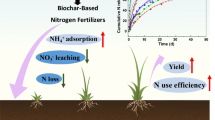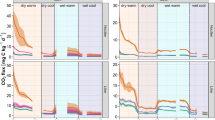Abstract
Summer fallow is very common in dryland agriculture to conserve rainwater and replenish soil fertility. However, bare land and intensive rainfall during summer fallow might result in a potential risk of N loss. We used a 15N-labelling method to study the loss of residual N fertilizer during summer fallow and its use by next wheat in the Loess Plateau. Our study included three treatments: without the addition of N (N0W0), with the addition of 50 kg ha−1 N (NW0) and with the addition of 50 kg ha−1 N plus 35% more water (NW). The N fertilizer (K15NO3) in solution was injected into the soil at a depth of 35 cm of the polyvinyl chloride (PVC) columns in field. The fates of 15N were followed after summer fallow and in the next season’s wheat (Triticum aestivum L.). The summer fallow of this study was a dry summer; however, fertilizer 15N was still leached down to 40-cm depth for the NW0 treatment; and for the NW treatment, the peak of 15N fertilizer was approximately 20 cm deeper. After summer fallow, the loss of the initially applied 15N was 26% in the soil profile for the NW0 treatment; and for the NW treatment, it increased to 37%. Soil 15N abundance in 0–20 cm of the NW0 and NW treatments was higher than the N0W0 treatment, indicating the upward movement of 15N in summer fallow. After the next wheat harvest, 15N uptake by wheat in the NW treatment decreased from 21.0 to 18.6% compared to the NW0 treatment. High rainfall during summer fallow increased residual N loss during summer fallow but decreased its use by the next crop.







Similar content being viewed by others
References
Asseng S, Richter C, Wessolek G (1997) Modelling root growth of wheat as the linkage between crop and soil. Plant Soil 190:267–277
Bremner JM (1996) Nitrogen-total. In: Sparks DL, Page AL, Johnston CT, Summ ME (eds) Methods of soil analysis part 3. Chemical methods. SSSA Book Ser. No. 5. SSSA, Madison, WI, p 1058–1121
Campbell CA, Biederbeck VO, Warder FG, Robertson GW (1973) Effect of rainfall and subsequent drying on nitrogen and phosphorus changes in a dryland fallow loam. Soil Sci Soc Am J 37:909–915
Clarke AL, Russell JS (1977) Crop sequential practices. In: Russell JS, Greacen EL (eds) Soil factors in crop production in a semi-arid environment. University of Queensland Press, St. Lucia, pp 279–300
Congreves KA, Dutta B, Grant BB, Smith WN, Desjardins RL, Wagner-Riddle C (2016) How does climate variability influence nitrogen loss in temperate agroecosystems under contrasting management systems. Agric Ecosyst Environ 227:33–41
Corbeels M, Hofman G, Van Cleemput O (1998) Analysis of water use by wheat grown on a cracking clay soil in a semi-arid Mediterranean environment: weather and nitrogen effects. Agric Water Manag 38:147–167
Cui SH, Shi YL, Groffman PM, Schlesinger WH, Zhu YG (2013) Centennial-scale analysis of the creation and fate of reactive nitrogen in China (1910-2010). PNAS 110:2052–2057
Cui ZL, Wang GL, Yue SC, Wu L, Zhang WF, Zhang FS, Chen XP (2014) Closing the N use efficiency gap to achieve food and environmental security. Environ Sci Technol 48:5780–5787
Dai J, Wang ZH, Li MH, He G, Li Q, Cao HB, Wang S, Gao YJ, Hui XL (2016) Winter wheat grain yield and summer nitrate leaching: long-term effects of nitrogen and phosphorus rates on the Loess Plateau of China. Field Crop Res 196:180–190
Dai J, Wang ZH, Li FC, He G, Wang S, Li Q, Cao HB, Luo LC, Zan YL, Meng XY, Zhang WW, Wang RH, Malhi SS (2015) Optimizing nitrogen input by balancing winter wheat yield and residual nitrate-N in soil in a long-term dryland field experiment in the Loess Plateau of China. Field Crop Res 181:32–41
Follett RF (2001) Innovative 15N microplot research techniques to study nitrogen use efficiency under different ecosystems. Commun Soil Sci Plan 32:951–979
Gao YJ, Li Y, Zhang JC, Liu WG, Dang ZP, Cao WX, Qiang Q (2009) Effects of mulch, N fertilizer, and plant density on wheat yield, wheat nitrogen uptake, and residual soil nitrate in a dryland area of China. Nutr Cycl Agroecosyst 85:109–121
Garbrecht JD, Nearing MA, Shields FD Jr, Tomer MD, Sadler EJ, Bonta JV, Baffaut C (2014) Impact of weather and climate scenarios on conservation assessment outcomes. J Soil Water Conserv 69:374–392
Gathumbi SM, Cadisch G, Buresh RJ, Giller KE (2002) Subsoil nitrogen capture in mixed legume stands as assessed by deep nitrogen-15 placement. Soil Sci Soc Am J 67:573–582
Gu BJ, Ge Y, Chang SX, Luo WD, Chang J (2013) Nitrate in groundwater of China: sources and driving forces. Glob Environ Chang 23:1112–1121
Gu BJ, Ju XT, Chang SX, Ge Y, Chang J (2017) Nitrogen use efficiencies in Chinese agricultural systems and implications for food security and environmental protection. Reg Environ Chang 17:1217–1227
Gu BJ, Ju XT, Chang J, Ge Y, Vitousek PM (2015) Integrated reactive nitrogen budgets and future trends in China. PNAS 112:8792–8797
Hauck RD, Meisinger JJ, Mulvaney RL (1994) Practical considerations in the use of nitrogen tracers in agricultural and environmental research. In: Weaver RW, Angle S, Bottomley P, Bezdicek D, Smith S, Tabatabai A, Wollum A (eds) Methods of soil analysis part 2. Microbiological and biochemical properties. American Society of Agronomy, Madison, pp 907–951
He G, Wang ZH, Li FC, Dai J, Ma XL, Li Q, Xue C, Cao HB, Wang S, Liu H, Luo LC, Huang M, Malhi SS (2016) Soil nitrate-N residue, loss and accumulation affected by soil surface management and precipitation in a winter wheat-summer fallow system on dryland. Nutr Cycl Agroecosyst 106:31–46
Huang ZL (1992) The Heilu soil. In: Guo ZY, Huang ZL, Feng LX (eds) . Shannxi soil. Science publisher, Beijing, pp 52–67 (in Chinese)
Ju XT, Gao Q, Christie P, Zhang FS (2007) Interception of residual nitrate from a calcareous alluvial soil profile on the North China Plain by deep-rooted crops: a 15N tracer study. Environ Pollut 146:534–542
Karbozova-Saljnikov E, Funakawa S, Akhmetov K, Kosaki T (2004) Soil organic matter status of Chernozem soil in North Kazakhstan: effects of summer fallow. Soil Biol Biochem 36:1373–1138
Ladd JN, Amato M (1986) The fate of nitrogen from legume and fertilizer sources in soils successively cropped with wheat under field conditions. Soil Biol Biochem 18:417–425
Laville P, Lehuger S, Loubet B, Chaumartin F, Cellier P (2011) Effect of management, climate and soil conditions on N2O and NO emissions from an arable crop rotation using high temporal resolution measurements. Agric For Meteorol 151:228–240
Liang B, Yang XY, Murphy DV, He XH, Zhou JB (2013) Fate of 15N-labeled fertilizer in soils under dryland agriculture after 19 years of different fertilizations. Biol Fertil Soils 49:977–986
López-Bellido L, Muñoz-Romero V, López-Bellido RJ (2013) Nitrate accumulation in the soil profile: long-term effects of tillage, rotation and N rate in a Mediterranean Vertisol. Soil Tillage Res 130:18–23
Menezes RSC, Gascho GJ, Hanna WW, Cabrera ML, Hook JE (1997) Subsoil nitrate uptake by grain pearl millet. Agron J 89:189–194
Min LL, Shen YJ, Pei HW, Jing BD (2017) Characterizing deep vadose zone water movement and solute transport under typical irrigated cropland in the North China Plain. Hydrol Process 31:1498–1509
Minick KJ, Pandey CB, Fox TR, Subedi S (2016) Dissimilatory nitrate reduction to ammonium and N2O flux: Effect of soil redox potential and N fertilization in loblolly pine forests. Biol Fertil Soils 52:601–614
Nosalewicz M, Stepniewska Z, Nosalewicz A (2013) Effect of soil moisture and temperature on N2O and CO2 concentrations in soil irrigated with purified wastewater. Int Agrophys 27:299–304
Peng L, Peng XL, Lu ZF (1981) The seasonal variation of soil NO3 −-N and the effect of summer fallow on the fertility of manured loessial soil. Acta Pedol Sin 18:211–222 (in Chinese)
Plaza-Bonilla D, Arrúe JL, Cantero-Martínez C, Fanlo R, Iglesias A, Álvaro-Fuentes J (2015) Carbon management in dryland agricultural systems. A review. Agron Sustain Dev 35:1319–1334
Pu GX, Saffigna PG, Xu ZH (2001) Denitrification, leaching, immobilization of 15N-labelled nitrate in winter under windrowed harvesting residues in hoop pine plantations of 1-3 years old in subtropical Australia. For Ecol Manag 152:183–194
Sebilo M, Mayer B, Grably M, Billiou D, Mariotti A (2004) The use of the 'ammonium diffusion’ method for δ15N-NH4 + and δ15N-NO3 − measurements: comparison with other techniques. Environ Chem 1:99–103
Sebilo M, Mayer B, Nicolardot B, Pinay G, Mariotti A (2013) Long-term fate of nitrate fertilizer in agricultural soils. PNAS 110:18185–18189
Shan L (2002) Development trend of dryland farming technologies. Sci Agric Sin 35:848–855 (in Chinese)
Simpson JR (1960) The mechanism of surface nitrate accumulation on a bare fallow soil in Uganda. J Soil Sci 11:45–60
Standardization Administration of the People’s Republic of China (2008) Assessment of agroclimate impact: classification method of annual crop climate types, GB/T 21986–2008. Standardization Administration of China, Beijing (in Chinese)
Van Meter KJ, Basu NB, Veenstra JJ, Burras CL (2016) The nitrogen legacy: emerging evidence of nitrogen accumulation in anthropogenic landscapes. Environ Res Lett 11:035014
Wang Q, Li FR, Zhao L, Zhang EH, Shi SL, Zhao WZ, Song WX, Vance M M (2010) Effects of irrigation and nitrogen application rates on nitrate nitrogen distribution and fertilizer nitrogen loss, wheat yield and nitrogen uptake on a recently reclaimed sandy farmland. Plant Soil 337:325–339
Wang C, Wang S, Fu BJ, Li ZS, Wu X, Tang Q (2017) Precipitation gradient determines the tradeoff between soil moisture and soil organic carbon, total nitrogen, and species richness in the Loess Plateau, China. Sci Total Environ 575:1538–1545
Yang ZX, Jue W, Di HJ, Zhang LJ, Ju XT (2014) A 15N-labeling study of the capture of deep soil nitrate from different plant systems. J Integr Agric 13:167–176
Yang JC, Li YL (2007) Principles of geomorphology. Peking University Press, Beijing (in Chinese)
Zhou JY, Gu BJ, Schlesinger WH, Ju XT (2016) Significant accumulation of nitrate in Chinese semi-humid croplands. Sci Rep 6:25088
Zuo Q, Jie F, Zhang RD, Meng L (2004) A generalized function of wheat's root length density distributions. Vadose Zone J 3:271–277
Funding
This work was supported by the National Natural Science Foundation of China (31372137, 41671295), the National Key Research and Development Program of China (2017YFD0200106), and the 111 Project (No.B12007).
Author information
Authors and Affiliations
Corresponding author
Ethics declarations
Conflict of interest
The authors declare that they have no conflict of interest.
Additional information
Responsible editor: Zhihong Xu
Highlights
• 15N method revealed that more than half of residual N lost during summer fallow.
• The residual N was found to move downward and upward simultaneously in summer fallow.
• High summer rainfall decreased 15N uptake by the next season’s wheat.
Rights and permissions
About this article
Cite this article
Xia, M., Chen, Z., Gao, J. et al. Summer fallow increases loss of residual nitrogen fertilizer in dryland of the Loess Plateau: a 15N-labeled method. Environ Sci Pollut Res 25, 34155–34163 (2018). https://doi.org/10.1007/s11356-018-3347-6
Received:
Accepted:
Published:
Issue Date:
DOI: https://doi.org/10.1007/s11356-018-3347-6




